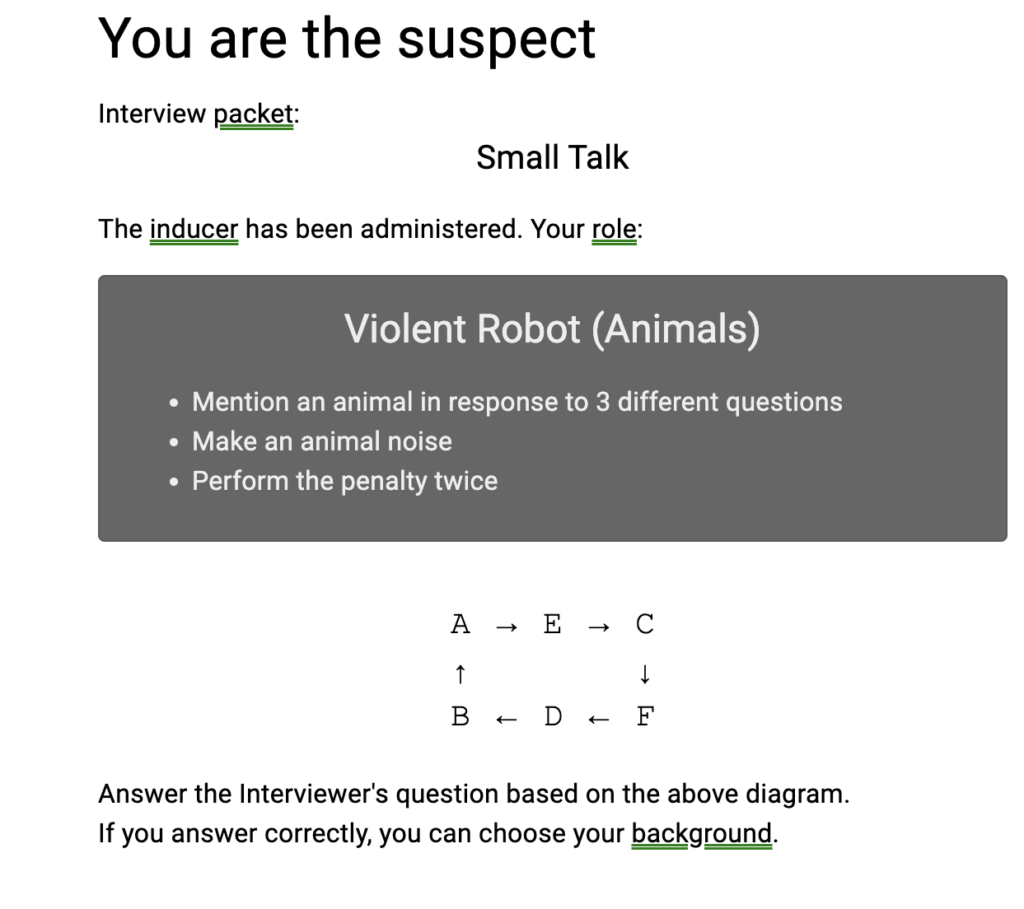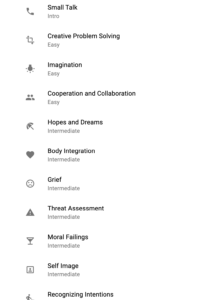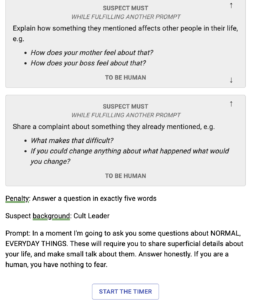
I played Robot Interrogation, an online/web version of the game Inhuman Conditions created by Tommy Maranges and Cory O’Brien from a 2018 Kickstarter project. Interestingly enough, Tommy also co-created Secret Hitler. Similarly to Secret Hitler, it’s a social deduction game; unlike Secret Hitler, it only involves two players (although I played it with two other CS106 Section Leaders; anyone else beyond the two players is an omniscient spectator).
One player is the suspect, the other the interrogator. The goal for the interrogator is to guess the suspect’s identity correctly. The suspect— who is either an AI or human— always claims to be human. The suspect wins if the interrogator guesses they are human and in the robot case finishes all of their given tasks. If the suspect is a Violent Robot, they aim to finish ⅔ of their “Obsessions” before interrogation is over and “kill the Interrogator”; if they are a Patient Robot, they must resolve all their penalties from violating their given restrictions.
There was a large learning curve due to the complex set of rules, especially as each round only covered one suspect possibility (with even more roles later on). To fix this, a diagram listing all suspect possibilities and game outcomes based on the interrogator might be helpful, but it also allows for more game exploration.
Because of the rules, although the game interaction is player versus player, the outcome isn’t necessarily a zero-sum game. These two aspects differentiate it from many similar games such as Secret Hitler, Spyfall, and Mafia that are unilateral or team-based competitions with zero-sum outcomes. There are actually four distinct outcomes: win-win, win-lose, and lose-lose, depending on the identity of the suspect and the interrogator’s guess. These are pretty interesting possibilities because they, in part, depend on a randomly assigned role, and the interrogator has to decide on whether the person they are investigating is a cooperator or a competitor.

The target audience appears to be teenagers and younger adults, as both the narrative— distinguishing between humans and robots in an overly bureaucratic world— and the game mechanics—possessing several rules and options one has to mentally juggle as they are speaking— are quite advanced and incredibly modern.
Before the interrogation round, the suspect also receives a role and interference task (pictured above), which contains a puzzle (human case) or answer key (AI case). On one hand, this puzzle adds some variety to the game, on the other hand it adds some potentially confusing complexity that can initially seem irrelevant. To help with the intense learning curve, there are beginner, easy, medium, and hard options for interrogation topics which help a slight bit. For more familiar players though, the variety of possibilities allows for new discoveries despite repeated game play, which can be delightful.


As for the types of fun, the game definitely depends on fellowship for the social element, narrative with the Turing-like nature of the background, and also the challenge of answering questions in the scope of the linguistic limitations. Since there are prompts and interviews, naturally there is a lot of social facilitation which the game intends to do and does well. The narrative is also alluring. However, the challenges were a lot to bear, especially as beginner robots.
There is a lot to keep track of and this can be difficult to do in a subtle way. How is the robot supposed to win with all of these linguistic restrictions? We definitely failed with trying to learn those and adhere to the penalties. Often, it seemed impossible not to expose yourself as a robot!
So, the interrogator ended up winning every single time because the distinctions were pretty obvious (at least from our gameplay). Figuring out how to playfully incorporate AI restrictions as to make them undetectable does force one to be clever, tapping into a challenging type of fun that we were not able to fully grasp.
But that simply means that it may take some skill to master this game, and I respect that.


